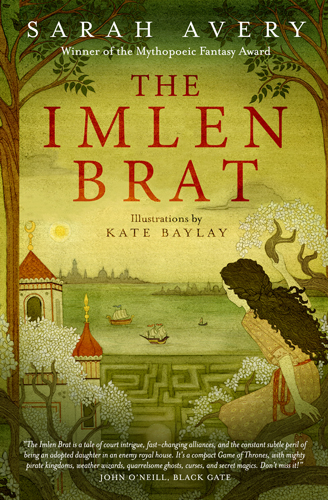Making Women From History Live
Working with BroadUniverse.org had been a delight because so many writers have not only shared their brilliant and entertaining stories, but also been so open about the challenges and process of creating a novel. Here today to share what it takes to make a woman from history come alive is Sarah Avery on The Imlen Brat.
 When I was a senior in college, I binged on biographies from the 1920s about women of the Italian Renaissance. Those old gentlemen biographers always tried to write in defense of the women who fascinated them, to argue that they were really proper ladies, perfectly innocent of all sorts of historical calumnies that were too raunchy to name on the page. Needless to say, the guy who tried to redeem Lucrezia Borgia really had his hands full.
When I was a senior in college, I binged on biographies from the 1920s about women of the Italian Renaissance. Those old gentlemen biographers always tried to write in defense of the women who fascinated them, to argue that they were really proper ladies, perfectly innocent of all sorts of historical calumnies that were too raunchy to name on the page. Needless to say, the guy who tried to redeem Lucrezia Borgia really had his hands full.
The figure who fascinated me most was Caterina Sforza, who at seventeen and in the seventh month of her pregnancy led her husband’s family guards to seize a fortress in Rome. She was the first in the family to find out that the Pope had died, and whenever a Pope died, the only way to make sure your noble family didn’t get purged in fire and blood was to control the Castel Sant’Angelo. Nobody else was home to get the job done, so she armored up and rode at the head of her troops.
She did a lot of daring stuff over the rest of her life, and she paid in suffering for her initiative. Caterina Sforza, like Lucrezia Borgia, was set up to fail by allies and relatives, set up to take a hit to the reputation for other people’s skullduggery, and treated as either a means to an end or as expendable when she wasn’t a means to an end.
I’d written my way into a chance to do creative writing for my senior thesis, which at Vassar is a pretty competitive thing. The trouble was, I’d won that chance with my poetry. Then I set out to write a fantasy novel with a narrator like those skittish 1920s gentleman biographers, with their obvious omissions, prissily-phrased innuendos, and axes to grind, about a kickass woman like Caterina Sforza who turns on her messed-up adoptive family when they send her out to get killed as a colonial governor in a colony they know they can’t hold. Sounds like fun, right?
The literary fiction guy who was my assigned thesis advisor was allergic to fantasy, literary or otherwise. “Nobody will ever want to read that stuff,” he said. I’m sure he knew that some authors writing that stuff outsold his respectable books ten to one, but what he really meant was that nobody he regarded would ever want to read that stuff. “You are here on the strength of your poetry, and frankly, that’s all I want to see from you,” he said. Now, I like to think I write mighty fine poetry, but it was clear to me that the problem here was with the reader, not the writer.
Anyhow, he was the person who decided whether I graduated, so I found a bunch of new poems to love, and promised myself I would come back to the novel about a character I had started to call Stisele.
After college, I made the biggest mistake of my life and got a Ph.D. It seemed like a good idea at the time, a path to a day job that would allow me to write. Nobody told me that the average time to completion for Ph.D.s in the humanities was ten years, or that the average dropout rate was about 75%. Nobody had told me that, even among the people who finish their degrees, only about 55% ever find full-time teaching gigs with, you know, health insurance and stuff. Eventually I accepted that it would have been better for my writing career if I’d dropped out, not only of grad school but out of college, spent my days as a barista at Starbucks, and then gone home to write whatever I damn well pleased without worrying about making my eventual case for tenure. It’s just that, by the time I had accepted it, I was eight years into my degree program and nearly done with my dissertation.
 When I finally escaped from academia, which is another story, I still had Stisele and her whole world in my head. She and her biographer and their city-state had accrued a lot of other stories and details, and several centuries of history in either direction. The first novel I finished writing, Spires of Beltresa, was set about two centuries after Stisele’s time, and her biographer is one of the secondary characters in a large-cast epic. To all those characters, Stisele is a figure of legend who means different things depending on what stake they have in opposing or supporting the troubled monarchy of Beltresa. Right now I’m actually revising that first novel, because my shiny new agent (Leon Husock of the L. Perkins Agency) is crazy in love with it. Spires of Beltesa has been in the trunk for a long time, too long for the market, or at least too long for my position in it until my collection of contemporary fantasy novellas, Tales from Rugosa Coven, won the Mythopoeic Fantasy Award in 2015.
When I finally escaped from academia, which is another story, I still had Stisele and her whole world in my head. She and her biographer and their city-state had accrued a lot of other stories and details, and several centuries of history in either direction. The first novel I finished writing, Spires of Beltresa, was set about two centuries after Stisele’s time, and her biographer is one of the secondary characters in a large-cast epic. To all those characters, Stisele is a figure of legend who means different things depending on what stake they have in opposing or supporting the troubled monarchy of Beltresa. Right now I’m actually revising that first novel, because my shiny new agent (Leon Husock of the L. Perkins Agency) is crazy in love with it. Spires of Beltesa has been in the trunk for a long time, too long for the market, or at least too long for my position in it until my collection of contemporary fantasy novellas, Tales from Rugosa Coven, won the Mythopoeic Fantasy Award in 2015.
When I first trunked Spires, I set out to write a shorter novel, one that had a single viewpoint character. The obvious stand-alone 100,000 word protagonist was Stisele. I thought National Novel Writing Month, or NaNoWriMo, with its crazily compressed composition schedule, would help me resist my tendency to write long, so I spent some months researching things I knew would be important to her. Stisele grows up to serve in Beltresa’s cavalry, so I spend a bunch of time hanging out in a dressage stable, learning about horses from a horse trainer whose mentor had been a Chilean cavalry officer. I took a horseback riding lesson for the first time in my life, and combed out a lot of long tails. In the spirit of NaNoWriMo, I made notes and outlines, maps and diagrams and chronologies, but waited to start the actual storytelling until November 1st.
Two Novembers later, I had 100,000 words of stuff that will eventually yield a novel, but is still fermenting. Maybe it’ll be my November book again this year.
But while I work on that, the opening chapter – movement, really – was a nicely self-contained novella about Stisele’s childhood. (I’m an accidental novella specialist.) She’s a wild, haunted, willful child, adopted and raised with complicated but real tenderness by the sovereign who ordered her birth mother’s death. Her adoptive siblings have to share their royal mother with this bratty child of illegal miscegenation. Stisele doesn’t look like the aristocratic descendants of Beltresa’s conquerors. Instead, she looks like her dead father’s commoner kin. The family dynamics with relatives both living and dead are gloriously messed up, and complicated by Stisele’s internalized racism. In The Imlen Brat, she’s seven years old, but she knows who the winners and the losers are in her world, and being a loser is mortally dangerous. Our girl’s got issues. Some of them she’ll struggle with all her life. But a few of them she’s able to wrestle with and triumph over in the space of the novella.
She also has to wrestle with the two imaginary friends who are not what they seem, a troublesome tendency to kin-curse her sister, the royal heir, and a subtle magical ability she’s never recognized until now. By the end of The Imlen Brat, we see Stisele still seven years old, starting her life over again with huge possibilities open before her and a changed understanding of her place in her family and her world.
When I ran the Kickstarter campaign to publish The Imlen Brat, I worked with a wonderful artist, Kate Baylay. The first time I saw her work online, I though she was some lost master from the golden age of illustration. Seriously, her stuff looks like the love child of Aubrey Beardsley and Erté, raised by Kay Nielsen, often with a subtly gothic edge. Google her and spend a glorious hour or two with her portfolio. She has a sort of Angela Carteresque way of starting with a classic fairy tale aesthetic, and then revealing all kinds of undercurrents that a child could look right at and never perceive. It was perfect for a novella about a child protagonist written for an adult audience. Anyhow, when I got in touch with Baylay, she was recently out of art school and little known outside of London. Now she’s getting to be quite a big fish. I’m still amazed and delighted that she accepted my offer of a commission. In addition to that wonderful cover art, she did four interior illustrations in black and white, which adds to the feeling that for the adult reader of looking through the lens of a child’s perception into a world more magnificently perilous than the child-hero can understand. That’s sense is just what made this novella, this part of Stisele’s larger story, so delicious to write. I’m grateful to all the Kickstarter backers who made it possible for me to send the book into the world with that art.
Buy Links:
Amazon – https://www.amazon.com/Imlen-Brat-Sarah-Avery/dp/0997414022
B&N – http://www.barnesandnoble.com/reviews/the-imlen-brat-sarah-avery/1124923462?ean=9780997414028
Kobo – https://www.kobo.com/us/en/ebook/the-imlen-brat
Powells – http://www.powells.com/book/the-imlen-brat-9780997414028/61-0
IndieBound – http://www.indiebound.org/book/9780997414028
About the Author
Sarah Avery’s collection of contemporary fantasy novellas, Tales from Rugosa Coven, won the Mythopoeic Fantasy Award in 2015. She grew up an Army brat in Kentucky and Korea, Japan and Germany, with a long stretch near Washington, D.C.
An escaped academic, Sarah wrote her doctoral dissertation on modernist poetry before returning to her first love, writing fantasy. Her short stories have appeared in Jim Baen’s Universe and Fantasy Scroll, as well as Black Gate, where she has been a columnist for many years.
With David Sklar, she coedited the themed anthology Trafficking in Magic, Magicking in Traffic, which included authors such as Elizabeth Bear and James Enge. She lives in Maryland with her husband and sons. You can visit her at http://sarahavery.com
Medium: https://medium.com/@Sarah_Avery
Twitter: https://twitter.com/SarahAveryBooks
Goodreads: https://www.goodreads.com/author/show/2746581.Sarah_Avery
Pinterest: https://www.pinterest.com/sarahaverybooks/
Facebook: https://www.facebook.com/sarah.avery.writer
Livejournal: http://dr_pretentious.livejournal.com
Amazon Author Page: https://www.amazon.com/-/e/B00H9ZB5RQ

